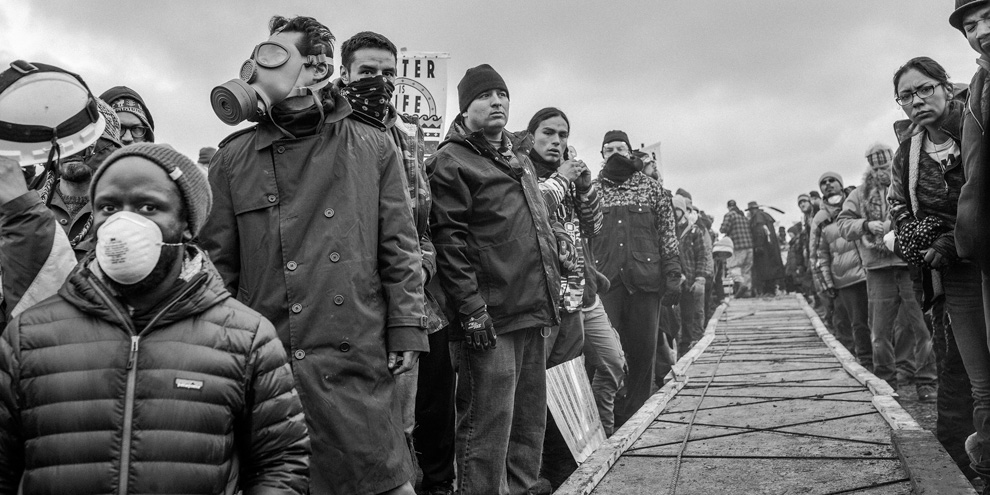Reilly Clark (’19) and Reily Haag (’19), co-presidents of the Profession Art Society of Stanford, head-curated an art exhibition, Badlands, currently at the O’Donohue Stanford Educational Farm. Focusing on indigenous photographer Josué Rivas’ photographs of protests at Standing Rock, Badlands also features work directly responding to Rivas’ intense images. The Daily sat down with Clark to discuss the experience of curating an exhibition, putting everything together and the stakes of such a project. As Clark notes in his curatorial essay, “We see in the eyes of his protestors the necessity of environmental justice. We consider their eyes. These are the Badlands.”
Badlands is open through May 13th at the O’Donohue Stanford Educational Farm.
The Stanford Daily: How would you describe what a head curator is, and what does it mean for you?
Reilly Clark: The Professional Art Society started from the ground up, doing everything from fundraising to finding a venue. We decided upon the O’Donohue Family Stanford Educational Farm. I had been working on the farm in the fall, and I got to know the director while working in the fields as they were erecting this beautiful new barn. PASS them did everything from finding the space to securing to money to reaching out to Josué, our headline artist, convincing him that we knew what we were doing and would respect his work. We did the same with Stanford faculty and MFAs, convinced them to make work specifically for the show, even as two of them were also making work for their second-year thesis show, which was incredible of them. I’m very lucky to have worked with such great artists, and the same goes for our undergraduate writers. PASS organized undergrad writers to write and publish in the catalog about everyone’s pieces. They were exceptionally kind and generous with their time.
TSD: How did Badlands treat the relation between art and truth?
RC: The first image of this in the show is of a group of protesters standing on either side of a man-made bridge. They were hoping to get to an island, the crest of which was occupied by private security, State Troopers, later the National Guard. There was very little outside media attention focused on the indigenous struggle from an indigenous perspective. And it almost always focused on conflict, the kinds of things that would get media hits. What I love about this photo is that you are led into this crowd of protesters. There’s this gorgeous composition move by which you walk along the bridge, but you’re met by their eyes. They look at you and return a kind of photographic, documentary gaze and accent the fact that they are not there to be consumed, they are not objects for American media consumption, they are not subjects for energy companies consumption but that they are resistors, they are eminently present. That’s the truth it’s about.
TSD: At what point did you realize that your vision was going to become realized?
RC: It felt strange creating a timeline for the show. ‘This is the time when you get on the train from Chicago to Stanford.’ ‘This is when you have to submit artwork.’ Telling my peers, my literal classmates, this is when your writing is due — it’s a very strange feeling. It felt real with big milestones. For example, Vice-Provost Harry Elam gave us a large bloc of funding; when that came through, it was very real. Mostly it was material, so when the catalogs came through, that was hyperreality. In the last week before the show went up, and artists had been making work special for the show, and I didn’t realize how cool that was until you visit their studios. For example, Sean Howe has a large piece that Reily Haag, my co-president, and I put onto dollies and rolled across campus. This massive cloud with several tectonic dollies. That felt very real, the physical artwork and installation. Meeting Josué also felt very real, seeing his live Instagram feed where he was getting on the train and talking about the show and coming to Stanford and how honored he felt to be a part of this.
TSD: Could you speak a little more about PASS?
RC: This is all the endeavor of the Professional Art Society of Stanford, which is a new student group in its first year, dedicated to social development among art students at Stanford, undergraduates, graduates, Art History, Art Practice. Anyone who’s just orbitally interested in the arts, whatever that means to them. We’re also dedicated to professional development in the arts. People get nuts and bolts experience like curating an exhibition or working with artists to write about their work. For the future, we’re always hoping for the opportunity to do more shows like this.
